This paper deals with the petroglyph site of Oum el Aleg near Akka in the far south of Morocco. The main subject of the paper is that I argue that there possibly are three images of archers, two of which possibly engaged in a hunting scene. The paper is accompanied by a video about Oum el Aleg, which can be viewed at YouTube.
By Maarten van Hoek
*
*
The Archers of Oum el Aleg, Morocco
*
Maarten van Hoek
*
Cover Photo: The boulder with the Third Archer Petroglyph at Oum el Aleg (looking NW), described in this study. Photograph © by Maarten van Hoek.
*
Introduction
Oum el Aleg is an extensive rock art site in the extreme southern part of Morocco. It is located a few kilometres SSE of the oasis of Akka (maps [see also Figure 4] and illustrations are available in my video), an ancient settlement that is situated in a “foum”, an easily passable gap in the 500 km long sandstone ridge of Jebel Bani, which literally forms the border line between the Anti-Atlas and the Sahara. Some four kilometres south of the village of Oum el Aleg, in a wind-blown, gravelly desert, is a V-shaped, sandstone ridge with numerous outcrops and boulders, some 250+ of which have been decorated with mainly zoomorphic petroglyphs. Most likely there are more, covered by desert sand or being unnoticed for some other reason.
The petroglyphs at Oum el Aleg have primarily been manufactured in the idiosyncratic Tazina Style (explained in: Pichler and Rodrigue 2003: 89 – 106), which mainly features biomorphic images with (often [excessively] long and thin) polished lines, which give a special and distinctive appearance to the images. Yet a few (more roughly executed) pecked petroglyphs occur, some of which depict abstract forms (often meandering lines) and a few zoomorphic figures, mainly cattle. Petroglyphs of anthropomorphs are (very) rare at this site (as well).
Oum el Aleg has been mentioned and described in several publications, but in this study I focus mainly on two books that describe the site more fully. The first book is the thesis about Moroccan Rock Art by Susan Searight (I only have the 2001-version on PDF: 137 – 148 [offering 16 illustrations]; 282 – 287; 304). Her thesis is – in general – very informative and some information about Oum el Aleg in this study has been derived from her thesis. Earlier, Searight also described the site in another publication (1996), which is not available online (her 2009-study still is [writing December 2023]). Although her thesis is easily readable and manageable, there are some minor inconsistencies that need to be addressed here.
Of a completely different order is the book by Renate Heckendorf (2008). It offers an enormous amount of much detailed information about a rather small area in southern Morocco. It also includes a description of the rock art at Oum el Aleg, confusingly labelled Tiounzîouine-1 by her. Unfortunately it took me a very long time to find out that her Tiounzîouine-1 actually represented the site of Oum el Aleg (KK5/01). Moreover, the text and the illustrations in her book are most inaccessible to any uninformed reader because Heckendorf uses numerous very complex codes (like Kat. KK5/01/014; S-LG-X and Typ S-MuL/FP) – without any explanation in the text – that are therefore enigmatic, making it almost impossible to read the book with pleasure. A fold-out with an explanation of all those codes would have been most helpful.
*
Confusing Labels
It is known that rock art sites have often been recorded by different names. However, seldom did I see so many different names for one site as with Oum el Aleg. The site was probably first recorded (1969) by Simoneau, who (in 1977) labelled the site Gara S. Mlaleg and Mlaleg Sud. However the site is also known as Mla’leg, Oum Alek, Oum La Leg, and Oumel Aleg, Oum Aleg, Oum El Alek, Oum el Aalag and as Tiounziouine (Searight 2001: 137; but listed there as Tiounzfouine [typo?] on her page 304) and Lakber el Khourchi. The site was also labelled as Tiounzîouine-1 and as KK5/01 by Renate Heckendorf (2008: 162), who – confusingly – did not mention any of the local names in her book (however, in her attachement – Anhang 5 / Katalog 6 / KK5 / Oum Aleg – there are 17 photos labelled Oum L’aleg). However, Susan Searight (2001) correctly mentions that there is another rock art site in the area – about 23 km SW of Oum el Aleg – that is called Tiounzfouine [typo?] (S50 by Searight 2001: 304; possibly labelled Tiounzîouine-2 by Heckendorf). To avoid confusion I prefer to follow Susan Searight (2001) who appropriately decided to use the name under which the site was first published (Simoneau 1969): Oum el Aleg (yet confusingly labelled Gara Sud Mlaleg by Searight [2001: 304]).
*
The Site
The V-shaped ridge at Oum el Aleg has a west (or north) branch pointing to the NE and an east (or south) branch, also pointing to the NE. The west (north) branch has the majority of the decorated panels (about 210 examples; roughly 85 %). The gap between the two branches is about 1100 m wide at its maximum. My wife and I only surveyed a part of the site, lacking time to explore the whole length of the 7000 m long ridge and the often 20 to 50 m wide tract to be followed (several publications mention a length of only 3 km, while [according to Google Earth] the total length of the V is in fact 7 km). Therefore, in the video that I created of Oum el Aleg, I am only able to present a selection of panels and images that my wife and I explored in 2019. Besides lack of time, another disadvantage was that it was impossible during our survey to have perfect slanting sunlight on all panels with petroglyphs, which – moreover – are often very much weathered, rendering some petroglyphs even almost invisible. Therefore, all photographs that we took, have been enhanced in order to more clearly show the images (and even then several images are still hard to identify, especially regarding the animal species).
*
Confusing Numbers
Although I realise very well (based on my own experiences in the field worldwide) that almost every survey or inventory of a large and complex rock art site may well be statistically incomplete or graphically inaccurate, it is remarkable to notice that there are puzzling differences within the books by Searight and Heckendorf, and also between those two books. The differences relevant for this study mainly concern the numbers and interpretation of two zoomorphic species and of the anthropomorphic figures at Oum el Aleg.
In her 2001-thesis Searight also lists the totals of the several types of petroglyphs at Oum el Aleg (2001: Table 24; 304; S48 – Gara Sud Mlaleg), among which are two giraffes, eleven rhinoceroses, seven elephants, and ten anthropomorphs (including four possible examples). These species – especially the anthropomorphic petroglyphs – are relevant in this study and will be discussed in more detail.
*
Rhinoceroses
Regarding the rhino-species it is important to know that Searight mentions (2001: 146) that the eleven rhinoceroses recorded, were always alone, except for the two examples that appear on one panel of a boulder at the east (south) branch (2001: Fig. 37b), and one with a group of three antelopes on the northern branch. Thus it seems that she overlooked the two petroglyphs of rhinos that have been illustrated by Simoneau (1977: 45; Planche 41) at “Mlaleg Sud”, while on the same panel there is also a small, yet important anthropomorphic figure, to which I shall return in this study. However, it is also possible (but very unlikely) that the petroglyphs illustrated by Simoneau were in fact found at a (very) nearby site. Interestingly, Heckendorf (2008: 165) mentions the presence of (only!?) three rhinos at Oum el Aleg.
*
Giraffes
Regarding the giraffe-species Searight mentions that there are only two unambiguous petroglyphs of giraffes (2001: Table 24; 144) and that both are found at the west (north) branch. However, she also states that in the first 360 m of the west (north) ridge there are no petroglyphs of giraffes (2001: 282). The first giraffe petroglyph on the east end of the west (north) ridge she recorded is her Petroglyph 32 (according to the photo in Searight [145; Fig. 36c]). Much further west she recorded Giraffe Petroglyph 185 (2001: 286).
However, at the very east end of the west (north) ridge there is a giraffe petroglyph that she seems to have interpreted as an antelope. Importantly, at that spot Searight recorded her Boulder 18 (2001: 282) featuring – according to her – two antelopes, one above the other. However, the better visible petroglyph of the two zoomorphs (Quadruped-1 in the video) I prefer to classify as a giraffe. Indeed, this purported giraffe – having a rather long, thin neck and a slight hump at the shoulders – superimposes a very faint second zoomorphic petroglyph (2 in the video: another giraffe or – more likely – an antelope?). If I am right, it might imply that there are three giraffe petroglyphs at Oum el Aleg. Heckendorf mentions the presence of (only!?) one giraffe at Oum el Aleg (2008: 165).
When it comes to interpreting prehistoric zoomorphic rock art images, it often proves to be in several cases a most hazardous task to identify the species correctly. This is evidenced by the case described in the last paragraph, but is also demonstrated by other photographs of quadrupeds made by Searight, who in every case may be right, especially as I am not claiming at all to be an expert in interpreting Tazina Style petroglyphs of biomorphs (often featuring exaggeratedly long lines). For instance, Searight describes and illustrates the zoomorphic petroglyph on Boulder 198 (2001: Fig. 36b) as an antelope (still having a rather long neck) and most likely she is right. However, also another zoomorph is also interpreted by her as an antelope (Searight 2009: photo 18), while that animal has an excessively long neck. In my opinion it might also be a giraffe. Concluding, I leave it to the experts to decide whether Petroglyph 1 (see my video) is a giraffe or not. Also for that reason often I prefer to use the term quadruped and/or antelope (which includes all sorts of gazelles, hartebeests etc.).
*
Anthropomorphs
In view of the main subject of this study – the archer – it is interesting to note that Searight recorded only six certain humans (four others were vague filiform shapes; possible anthropomorphic figures [2001: Table 24; 146]). In contrast, Heckendorf (2008: 165) mentions the presence of (only!?) two anthropomorphic figures at Oum el Aleg. Remarkably, Searight only mentioned anthropomorphs on a panel together with an elephant (?) and another with a possible sheep. Importantly, Searight (2001: 282) recorded this purported elephant on the west (north) ridge on Boulder 21; the animal being followed by one anthropomorph and one quadruped. This may well be the important scene illustrated (2008: Anhang 5 – Katalog 6 – KK5; KK5/01/014/01 to 03) and described by Heckendorf. However, in the whole study of Oum el Aleg, Searight does not mention an archer, while Heckendorf suggests that the anthropomorph on Boulder 21 might well be an archer chasing the purported elephant. This confusion brings me to discuss the possible representations of the archer at Oum el Aleg.
*
Moroccan Archer Petroglyphs
Introduction
In general it can be stated that rock art images of archers are relatively (very) rare in Morocco. Simoneau once stated that there are about 25 rock art images of archers in southern Morocco (1977: 45). A very small number of possible examples have been recorded in the High Atlas (Rodrigue 1999: 298, 327, 351, 353), but also the rock art repertoire of the Anti-Atlas and adjoining deserts immediately south of the Anti-Atlas has a small quantity of petroglyphs depicting archers, like the example at Guelta Oukas (Blanc et al. 2003: Fig. 15; see Figure 5).
Also in our area around Akka examples have been reported, for instance at Aït Ouabelli (labelled Taheouacht by me in my 2020-paper and indicated by Heckendorf [2008] as Oum el Fkarn, Melfkari and Bezet / Sites FH4/06 and FH4/07; Van Hoek 2020: Fig. 9). At Taheouacht-2 (Aït Ouabelli East; FH4/07 according to Heckendorf) we noticed two large fully pecked petroglyphs of giraffes surrounded by up to five (outlined) archers, aiming their arrows at those animals (although Heckendorf [2008: 179; Abb. 64] correctly suggests that the scene may involve a later addition of the archers). Heckendorf illustrates another archer at Taheouacht-1 (Aït Ouabelli West; her Oum el Fkarn / FH4/06; 2008: Abb. 61). Also at the rock art sites of TM1/01 (Heckendorf 2008: Abb. 20 [four archers hunting an animal]; Abb. 96), FH6/04 (Heckendorf 2008: Abb. 67) and KK8/04 (Heckendorf 2008: Abb. 91) archers have been reported. Simoneau (1977: Planche 43) also describes three small (masked?) archers at the site of Maarda (a few km NE of Oum el Aleg; see Figure 4), although Searight doubts that the figures are really archers (2001: 206; although she included the figures as “archers” in her inventory [2001: 304; S46]). Searight also mentions petroglyphs of archers at the site of Tamzarar, Aït Ouabelli (2001: 308; S104). Finally, much further east Rodrigue (2001: Fig. 3.5) reported the very simple petroglyphs of three archers at the rock art site of Akka-Izam. Of course there are more examples in southern Morocco, as will be demonstrated further down.
Most of the archer petroglyphs in our study area are only simple representations, generally without (any) detail. Sometimes the bow is just represented by a simple curved line (no strings attached) and arrows are only simple lines (while sometimes arrows are even lacking). Some of the archers seem to carry some sort of backpack on their backs (like at least two examples in the purported giraffe-hunt at Taheouacht-2 [Aït Ouabelli East; FH4/07 according to Heckendorf 2008]). Moreover, none of the archers in the study area seem to be fighting each other or are engaged in a conflict, although a few (possible) hunting scenes have been recorded, for instance at TM1/01, FH4/06, FH4/07 and FH6/04 (Heckendorf 2008: resp. Abb. 20. 61, 64 and 67).
*
The Archers of Oum el Aleg
ARCHER 1
It is remarkable that Searight does not mention any image of an archer in her thesis (2001). Moreover, also a panel with an obvious petroglyph of an archer – reported earlier by André Simoneau (1977: Planche 41) – has not been mentioned or referred to (although she refers to the 1977-paper by Simoneau quite often). Importantly, the petroglyphs on that panel have also been illustrated by Simoneau (Figure 1), stating that the panel was recorded by him “at Mlaleg Sud” (1977: Planche 41). His black-and-white sketch shows a large rhino and a much smaller rhino (both looking to the right) and a petroglyph of an outlined archer (said by Simoneau to be 15 cm in height) who is looking in the same direction as the two (outlined) rhinos. For that reason I assume that the scene does not involve a hunting scene. Also in this case the (clearly phallic) archer may be of another (earlier or later?) date (compare this suggestion with the purported giraffe-hunt at Taheouacht-2 / Aït Ouabelli East discussed above).
Figure 1. A: Sketch of a panel at Oum el Aleg with two rhinos and an archer. Drawing © by Maarten van Hoek, based on the B&W sketch by Simoneau (1977: Planche 41). B: Sketch of the archer. Drawing © by Maarten van Hoek, based on a photo by Simoneau (1976: Fig. 22).
Click on any illustration to see an enlargement (which can again be enlarged again).
The outlined archer has an outlined backpack on its back and carries a simple bow, apparently with two long arrows that point away from the rhinos (Figure 1B). Simoneau states that the configuration of an archer followed by rhinos is unique in the rock art of southern Morocco (1977: 45). The photos that I have found on the internet show more extremely faint lines that might be anthropic. This makes it highly desirable to re-locate this panel and scan it thoroughly.
In my files I have a photo of the panel showing the two rhinos, as well as – though extremely faintly – the archer (confirming the accuracy of the [yet incomplete] sketch by Simoneau [Figure 1A]). The only scientifically published photo of the archer that I have available (which unfortunately does not show the rhinos) appears in the paper by Simoneau describing the petroglyphs of rhinos in the Dra-Bani area (1976: Fig. 22). His caption also states that it is found “at Mla’leg”, which confirms again that the archer is at least from Oum el Aleg (or perhaps a more isolated, minor site very near Oum el Aleg). Despite this minor uncertainty regarding the location, I regard this image to be the first true archer petroglyph recorded at Oum el Aleg.
*
ARCHER 2
There is a panel at Oum el Aleg that has been included in the inventory by Searight (2001: 282; Petroglyph 21) without identifying the anthropomorphic component as a (possible) archer. Instead, Renate Heckendorf (2008: 165 and Note 508) seems to identify that small anthropomorphic figure (her KK5/01/014/03) as a possible archer, while on the same panel she also noticed the petroglyphs of a gazelle and an elephant (her KK5/01/014/01); the latter animal said by her to possibly be the target of the purported archer. Her photograph (Anhang 5 – Katalog 6 – KK5) indeed shows a large outlined animal (an elephant?) followed by a small (possibly chasing) anthropomorphic figure and a small (unrelated?) quadruped. Unfortunately, the purported archer in the photo published by Heckendorf was too small to make a reliable drawing of. Therefore, the drawing in my Figure 2 only serves to present a very rough sketch of what is visible in Heckendorf’s photo. Especially the layout of the purported archer may well be inaccurate (hence the “?”). If Heckendorf is right, then this images represents the second archer petroglyph at Oum el Aleg.
Figure 2. The possible (!) hunting scene on a panel recorded by Heckendorf at Oum el Aleg. Drawing © by Maarten van Hoek (a very rough and probably inaccurate sketch, especially regarding the layout of the purported archer, of which the bow-and-arrow may even be completely erroneous), based on the photo by Heckendorf (2008: Anhang 5 – Katalog 6 – KK5).
*
ARCHER 3
On the west (north) branch of the V-shaped ridge of Oum el Aleg my wife Elles and I recorded petroglyphs on a panel that I could not trace in the inventory by Searight (2001: 282 – 287). The panel (Figure 3; see also the Cover Photo for the location) features at least one image of an unambiguous zoomorphic figure (a quadruped, most likely an antelope or perhaps a bovine). To the right of this zoomorph is a petroglyph that I prefer to interpret as an anthropomorph, and – more importantly – as a possible (!) archer, aiming its almost invisible (worn-off) bow (and arrow?) at the zoomorph. If my interpretation is correct, then this personage will represent the third archer at Oum el Aleg.
Figure 3. The possible (!) hunting scene on a panel at Oum el Aleg, first (?) identified as such by Elles and Maarten van Hoek in 2019. Photograph © by Maarten van Hoek.
*
Conclusions
It will not come as a surprise that three “new” archer petroglyphs can be added to the rock art repertoire of southern Morocco. Although Simoneau once listed 25 rock art images of archers in southern Morocco (1977: 45), the number of archer images has definitely increased since then. For instance, Searight (2001: 303) does not mention archers at the rock art sites of Imgrad Tayaline (S 35) and neither at nearby Adrar n’Metgourine (S34), two sandstone outcrops just north of Akka, but several years later Faysal Lemjidi reported a total of four, perhaps even five archer petroglyphs at both sites (resp. 2019a: drawings P9171690 and P9171905; 2019b: Figs 4 and 11 and perhaps 12). Earlier Blanc et al. (2003: Fig. 15) recorded an example at Guelta Oukas (see Figure 5; Van Hoek 2015). Finally, I have a photo in my files of a petroglyph panel at Tiounziouine (also referred to as Tizounine; Touzounine) – a small site we visited about 23 km SW of Oum el Aleg – that is said by a local to include an archer, but the panel is too much weathered to be positive about that statement. Notwithstanding those new additions it can be claimed that representations of archers are very rare in the rock art of Morocco.
What also seems to be evident, is that petroglyphs of archers in the rock art of southern Morocco are almost always found at Tazina Style rock art sites and often (though still rarely) directly associated with Tazina Style zoomorphic petroglyphs (rhinos, antelopes, elephants etc). Tazina Style rock art sites are found mainly in a long belt stretching from the Atlantic coast in the west to the far east (Gauthier et al. 2010: Fig. 1). A petroglyph of a Tazina Style archer has been recorded as far east as the rock art site of Oued Azidj, Algeria (Gauthier et al. 2010: Fig. 25), roughly 1246 km SE of Oum el Aleg. Finally, it is also significant that the majority of the Moroccan archer petroglyphs is found in a 35 km radius around the oasis of Akka (Figure 4) (with possibly 25+ examples), where also most (purported) hunting scenes have been recorded.
Figure 4. Map of the study area around the oasis of Akka. Green squares indicate the sites with petroglyphs of (possible) archers (all locations approximated). Map © by Maarten van Hoek, based on the map © by OpenStreetMap – Contributors.
This study seems to suggest that there are no images of archers elsewhere in southern Morocco and adjacent areas. Indeed, they seem to be lacking in the characteristic Libyco-Berbère Style, which is most characteristic in this area, especially at the petroglyph site of Foum Chenna, further upstream in the Draa Valley (Van Hoek 2014). Yet there are more archers in the south of Morocco than the 25 petroglyphs of archers mentioned by Simoneau (1977: 45) and the 40+ (?) petroglyphs mentioned in this study. There are also a few sites with pictographs depicting archers, like the two examples at Foum Laachar / Idmi Ifran West (Jbel Bani), 220 km ENE of Oum el Aleg (Moumane et al. 2019: Fig. 5). But there are more pictographs of archers not far from the Atlantic coast, roughly 500 km SW of Oum el Aleg.
Figure 5. Archer petroglyph (phallic?) at Guelta Oukas; Wadi Tamanart (bow added?). Photograph © by Heribert Bechen, Germany.
In the far west of southern Morocco (including the far north of Mauritania; however, modern boundaries are completely irrelevant when discussing rock art) there are several rock art sites with rare pictographs of archers that have survived in caves or rock-shelters, like the red painted, often phallic archers recorded on several panels at the rock art site of Azguer or Aouinat Asguer (Gauthier and Gauthier 2021: Fig. 101), located about 300 km SW of Oum el Aleg. Also the complex of rock art sites at Oummat Chegag (in Mauritania, 295 km SSW of Azguer) and at several in-between sites are relatively many pictures of archers (Gauthier and Gauthier 2021: several illustrations). One unique scene even depicts two groups of archers apparently fighting each other (Gauthier and Gauthier 2021: Fig. 75). Scenes of conflicts between archers are absent in the Oum el Aleg area. On the other hand, some archers at Oummat Chegag carry a kind of backpack (Gauthier and Gauthier 2021: Figs 57 and 82), resembling the ones around Oum el Aleg. It must be thus concluded that rock art images of archers in both distant areas reflect similarities in layout and traditions (hunting scenes appear in both areas), yet apparently different customs in the Oum el Aleg area, than in the Oummat Chegag area, where possibly more conflicts occurred at that time.
*
Acknowledgements
Again I am grateful to Heribert Bechen for his kind permission to use and publish his photographs of Moroccan rock art, one of which has been used in this study (Figure 5). I am – as usual – much indebted to my wife Elles for her assistance in the field and her ongoing support at home, while preparing this study.
*
References
Blanc, C., W. Pichler and A. Rodrigue. 2003. Le site rupestre de Guelta Oukas (Morocco). Almogaren XXXIV; pp. 79 – 111. (Institutum Canarium), Wien.
Gauthier, Y., B. Veneur, N. Desaphy and P. Seuriel. 2010. Nouvelles gravures en style de Tazina: figurations du Nord de l’Immidir, Algérie. Almogaren. Vol. XLI; pp. 149 – 192. Wien.
Gauthier, Y. and Ch. Gauthier. 2021. Oummat Chegag (Mauritanie septentrionale) et les peintures des pays de la façade atlantique. Les Cahiers de l’AARS . Vol. 22; pp. 45 – 82.
Lemjidi, F. M. 2019a. “Imgrad n’Tayaline rock art data”. Mendeley Data.
Lemjidi, F. M. and apos, H. Bouajaja, N. Oulmakki and D. Bailly. 2019b. Les gravures rupestres de l’Adrar n’Metgourine: nouvelles données. Hespéris-Tamuda; Eléments d’archéologie préhistorique marocaine. LIV-3; pp. 225 – 240.
Moumane, A.; J. Delorme; A. Ewague; A. Jamal; M. Gaoudi; H. Ista; M. Moumane; H. Mouna; A. Oumouss; A. Lmejidi; N. Zdaidat. 2019. Jbel Bani Rock Art: Newly-discovered Shelters along Mountain Paths suggest a Significant Link between Central Sahara and North Africa (Zagora, Southern Morocco). Journal of African Archaeology. Vol. 17; pp. 1 – 17.
Pichler, W. and A. Rodrigue. 2003. The «Tazina Style». Sahara. Vol. 14; pp. 89 – 106.
Simoneau, A. 1976. Les rhinoceros dans les gravures rupestres du Dra-Bani. Antiquités Africaines. Vol. 10; pp. 7 – 31.
Simoneau, A. 1977. Catalogue des sites rupestres du Sud-Marocain. Ministere d’Etat charge des Affaires Culturelles. Rabat.
Rodrigue, A. 1999. Lárt rupestre du Haut Atlas marocain. L’Harmattan. Paris.
Rodrigue, A. 2001. La Station Rupestre d’Akka-Izam (Province de Tata, Maroc). L’Ouest Saharien. Vol. 3; pp. 15 – 22.
Searight, S. 1996. Un site rupestre du Sud-marocain: Oum el Aleg. Bull. Soc. Etudes et Rech. Des Eyzies. Vol. 45; pp. 67 – 82.
Searight, S. 2001. The Prehistoric Rock Art of Morocco. A Study of its extension, environment and meaning. Thesis presented in partial fulfilment of the requirements of Bournemouth University for the degree of Doctor of Philosophy. Bournemouth.
Searight, S. 2009. Oum El Aleg: un site de gravures rupestres. Bull. Arch. Maroc. Vol. XXI; pp. 69 – 92. https://insap.ac.ma/oum-el-aleg-un-site-de-gravures-rupestres/
Van Hoek, M. 2014. The Felines of Foum Chenna. In: TRACCE – Online Rock Art Bulletin, Italy.
Van Hoek, M. 2015. The Case of Guelta Oukas. Desecrated Rock Art Panels in the Anti-Atlas of Morocco. In: TRACCE – Online Rock Art Bulletin, Italy. Linked with my video “Le Site Rupestre de Guelta Oukas, Maroc”.
Van Hoek, M. 2019. The Book of Bows – The Archer in Desert Andes Rock Art. Oisterwijk, Holland. Book only available as PDF at ResearchGate.
Van Hoek, M. 2020. First Fighting, Then Mating. A “Unique” Petroglyph Scene in Southern Morocco. In: TRACCE – Online Rock Art Bulletin, Italy.

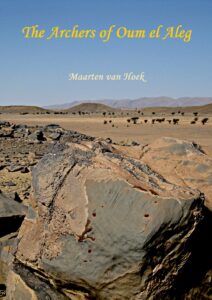
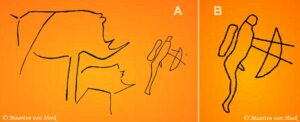
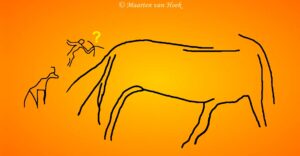
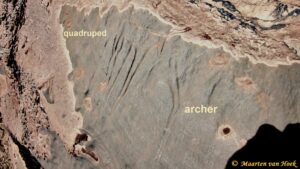
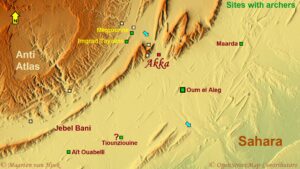
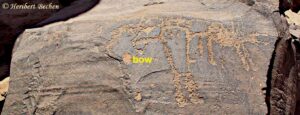














Leave a Reply